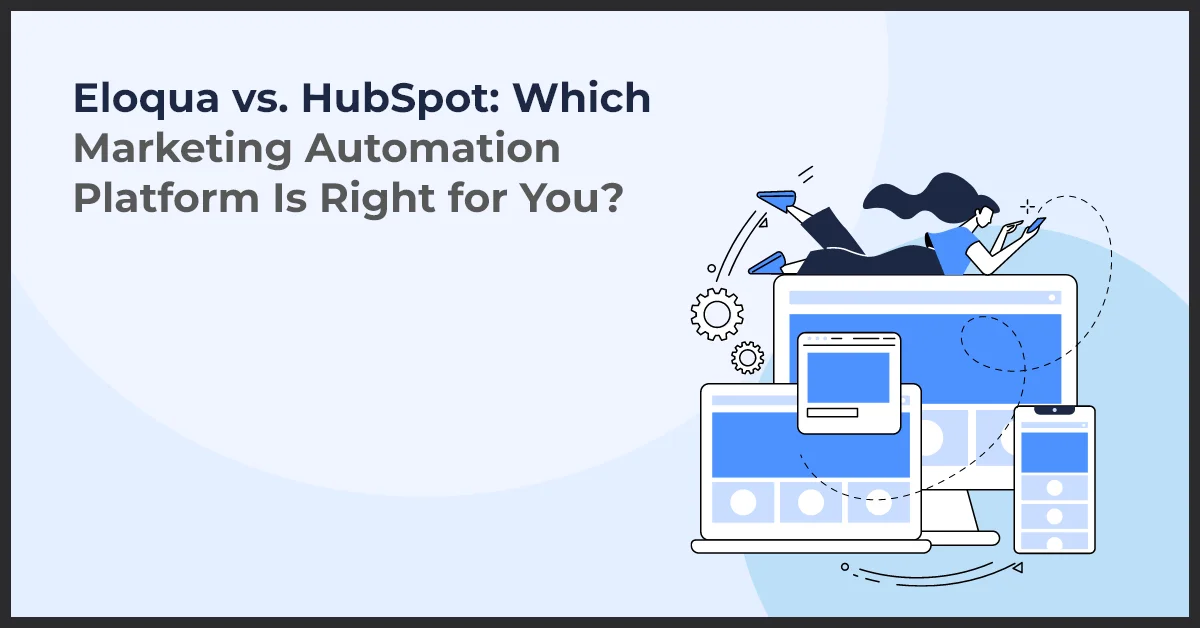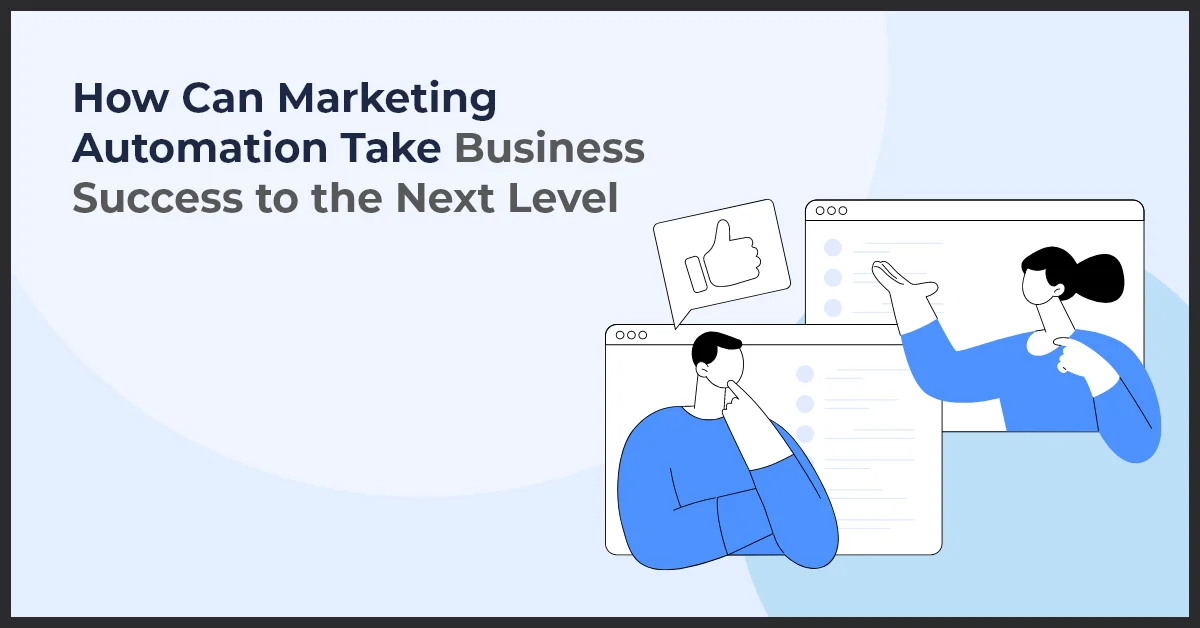Ways To Leverage Marketing Automation for Your Ecommerce Business

Published on: September 7, 2021
Updated on: July 02, 2024
1338 Views
- Marketing Automation
13 min read
The number of online users is increasing at a rapid pace and eCommerce automation is the only solution to meet the needs of a growing audience. For many teams, it is already difficult to perform autonomous and repetitive tasks throughout the day. By implementing automated solutions to your eCommerce operations, your team can utilize their time to pursue other aspects of business growth.
Direct involvement on the eCommerce platforms might seem fulfilling but it ultimately inhibits business scalability. After conducting thorough research you can determine which tasks should be delegated and which can be enhanced with automation.
Here are most important areas where you can leverage eCommerce automation to be able to focus on other strategic tasks:
Customer Segmentation in Ecommerce Marketing Automation
Customer segmentation plays a crucial role in e-commerce marketing automation. It involves dividing your audience into distinct groups based on various criteria such as demographics, behavior, and purchase history. By segmenting your customer base, you can create personalized marketing campaigns and targeted messaging that resonates with each segment.
Analyzing customer data is vital in customer segmentation. By understanding your customers' preferences, needs, and behaviors, you can tailor your marketing efforts accordingly. For example, you can send different offers or recommendations based on their past purchases or browsing patterns.
Segmenting your audience based on demographics allows you to create marketing messages that appeal to different age groups, genders, or geographic locations. By understanding the unique characteristics of each segment, you can deliver more relevant and personalized content.
Behavioral segmentation tracks and analyzes customer behavior, such as their interactions with your website, email engagement, or purchase history. This information helps you identify patterns and preferences, allowing you to target specific customer segments with relevant offers or promotions.
Moreover, segmenting based on purchase history enables you to create tailored campaigns for customers at different stages of the buying cycle. For instance, you can send personalized emails to customers who have abandoned their shopping carts, offering incentives to complete their purchases.
The benefits of personalized marketing campaigns and targeted messaging cannot be understated. When customers receive relevant and personalized content, they are more likely to engage with your brand, make a purchase, and become loyal customers. By providing a personalized experience, you enhance customer satisfaction and increase the chances of repeat business.
In summary, customer segmentation is an essential component of ecommerce marketing automation. By analyzing customer data and segmenting your audience based on demographics, behavior, and purchase history, you can create personalized marketing campaigns and targeted messaging. This level of personalization leads to increased customer engagement, loyalty, and ultimately, higher sales for your ecommerce business.
Email Marketing and Automation in Ecommerce
The significance of email marketing campaigns in successful ecommerce marketing automation
Email marketing campaigns play a crucial role in driving sales and engaging customers in ecommerce marketing automation. By leveraging the power of email, businesses can reach out to their target audience with personalized messages and offers, effectively nurturing relationships and driving conversions. Email marketing allows ecommerce businesses to stay top of mind and build customer loyalty, leading to repeat purchases and increased revenue.
Key elements of effective email marketing, including automated workflows, personalized content, and triggered emails
- Automated workflows: With email marketing automation, businesses can set up automated workflows that trigger targeted emails based on specific actions or events. This allows for timely and relevant communication with customers throughout their journey, from onboarding to post-purchase follow-ups.
- Personalized content: Personalization is key in email marketing. By segmenting your audience and tailoring your messages based on their preferences, purchase history, and behavior, you can deliver highly relevant content that resonates with your customers and drives higher engagement rates.
- Triggered emails: Triggered emails are sent in response to specific actions or events, such as abandoned carts, product recommendations, or order confirmations. By employing triggered emails, ecommerce businesses can deliver timely and targeted messages that drive conversions and encourage customer loyalty.
Integration of email marketing tools with ecommerce platforms to optimize results
To fully leverage the power of email marketing in ecommerce, businesses should integrate their email marketing tools with their ecommerce platforms. This integration allows for seamless data synchronization, enabling businesses to use customer data from their ecommerce platform to create personalized and targeted email campaigns. By leveraging the data collected through their ecommerce platform, businesses can optimize email marketing efforts and achieve higher conversion rates.
Personalization in Ecommerce Marketing Automation
The value of tailoring customer experiences through personalization in ecommerce marketing automation:
- Improved customer engagement and satisfaction
- Increased conversion rates and sales
- Enhanced customer loyalty and repeat purchases
Tactics for implementing personalization, such as:
- Personalized product recommendations based on past purchases and browsing behavior
- Dynamic website content that adapts to each customer's preferences and interests
- Customized offers and promotions tailored to individual customer needs and preferences
Leveraging customer preferences for personalized email campaigns:
- Segmenting customers based on their preferences and behavior
- Creating targeted email campaigns with personalized content and offers
- Using automation to send emails at the optimal time for each individual recipient
- Monitoring and analyzing email performance to continuously improve personalization strategies
Behavioral Tracking for Ecommerce Marketing Automation
Behavioral tracking plays a crucial role in marketing automation for ecommerce businesses. By understanding and tracking customer behavior, businesses can gain valuable insights into their customers' preferences and identify patterns that can help optimize their marketing strategies.
One of the key benefits of behavioral tracking is the ability to automate marketing actions based on customer behavior. This includes tracking website visits, purchases, abandoned carts, and email activities. By tracking these interactions, businesses can create personalized and targeted campaigns that are tailored to each customer's specific interests and needs.
Analyzing customer behavior is essential for understanding their preferences and identifying patterns. By monitoring how customers interact with a website, businesses can gain insights into what products or services they are interested in, what pages they visit the most, and what actions they take before making a purchase. This information can be used to segment customers into different categories and create targeted marketing campaigns that address their individual needs.
Automating marketing actions based on customer behavior is a powerful way to increase customer engagement and drive sales. For example, if a customer abandons their cart, businesses can automatically send a targeted email reminder to encourage them to complete their purchase. By leveraging behavioral tracking, businesses can deliver timely and relevant marketing messages that are more likely to resonate with their customers.
In conclusion, behavioral tracking is a vital component of marketing automation for ecommerce businesses. By analyzing customer behavior and tracking interactions, businesses can gain valuable insights, automate marketing actions, and create personalized campaigns that drive engagement and sales.
Lead Nurturing in Ecommerce Marketing Automation
Lead nurturing plays a vital role in the world of ecommerce marketing automation. It involves developing and maintaining relationships with potential customers who have shown interest in your products or services.
By leveraging automated workflows, you can nurture these leads by sending them targeted and relevant follow-up emails. These automated workflows ensure that potential customers receive the right information at the right time, increasing your chances of conversion.
One of the key aspects of lead nurturing is providing product information. By sending out emails that highlight the features, benefits, and uses of your products, you can entice customers to make purchases. These emails can include personalized recommendations based on the customer's preferences or previous purchases.
In addition to product information, delivering valuable content is also crucial in lead nurturing. By providing educational resources, blog articles, or guides, you can position yourself as an industry expert and build trust with your potential customers. This valuable content can help move prospects through the sales funnel and increase their likelihood of making a purchase.
Furthermore, lead nurturing allows you to segment your potential customers based on their behavior and preferences. By analyzing their interactions with your website, such as the pages they visit, the emails they open, or the products they view, you can tailor your follow-up emails to their specific interests. This personalized approach enhances the customer experience and improves the chances of conversion.
In conclusion, lead nurturing is an essential aspect of ecommerce marketing automation. By leveraging automated workflows, providing product information, enticing customers to make purchases, and delivering valuable content, you can effectively nurture potential customers and guide them through the sales funnel.
Cart Abandonment
Cart abandonment rates are a major issue for every online business. There can be many factors like unexpected shipping costs or maybe users were just window shopping. Through eCommerce automation, many of these abandoned carts can be turned into complete transactions.
Automated tools can help you reach out to them through emails. Automated cart abandonment emails are sent in response to an abandonment trigger action. Shopify and BigCommerce offer cart abandonment emails that can be configured to meet your site`s needs.
Time is of the essence and the first email needs to be sent within an hour of a cart’s abandonment. If the user doesn’t engage, then you can reach out to them with a secondary reminder within a few hours followed by a final reminder within 24 hours.
Do not go overboard with the emails as whenever users receive more than three emails, they are bound to flag you for spam. Make use of an eCommerce automation software during certain stages of a buyer’s journey to make a customer complete a purchase.
Abandoned cart emails also help in improving the conversion rates of visitors who left unwillingly due to technical issues. Customers feel valued if a brand approaches them and thus reaching out to them can improve the chances of future purchases.
Multiple email marketing platforms offer cart abandonment emails and can be easily incorporated into your eCommerce website with ease. These eCommerce automation systems are better equipped to help sites that have large traffic that cannot be monitored manually.
Social Media
For the highest traffic flow, a foothold in multiple platforms is necessary. Social media is no exception and is the best way to connect with modern-day users. Ideally, posting on one social media profile might not be a tremendous task but doing so on multiple platforms isn’t easy.
Moreover to stay ahead of the competition the key would be consistency. Irregular or lack of social media updates will not captivate users. Users are likely to forget such profiles unless it delivers constant updates to be within their minds.
Tools like Hootsuite allow you to post updates on multiple platforms from a single dashboard. This cuts down on the time needed to post updates. Instead of updating manually every day, these eCommerce automation solutions let you schedule updates for the whole month in a single sitting.
Another benefit of these eCommerce automation tools is that all the social media platforms get updated simultaneously. Tools like Hootsuite and Buffer are very helpful in utilizing peak traffic hours without the possibility of delays. However, as you deal with automation, do not forget to engage with your followers regularly.
Customer Service
Customer service is a very demanding sector and you need to implement eCommerce automation features carefully as it involves a lot of user interaction. Using partial automation is a good option for such cases as it fosters eCommerce automation without the complete elimination of manual aspects needed to deliver excellent customer service.
Customer service can be improved upon using eCommerce automation tools by streamlining customer interactions. With automated support options, it cuts back the need for direct engagements, thus reducing workload and resolving issues more efficiently.
Support tickets are also a useful customer service automation feature. They can be sorted according to their priority levels by the website and assigned automatically to the respective brand. Support tickets don’t get mixed with all email requests and are easier to find.
By eliminating the need for email filtering, the support team can identify issues and resolve them faster. However, customer support automation services do not guarantee conversion. The benefit of these eCommerce automation services is that they offer customer assistance without the need for an agent.
Inventory Management
Inventory management might not require eCommerce automation tools during the initial stages but you will need them as the eCommerce business scales up. Since you need to monitor a large number of goods/services, it is impossible to update everything manually.
Poor inventory management may lead to orders placed on out-of-stock products. It leads to multiple complications and refunds, which leads to a bad user experience, making inventory updates an important aspect that should not be overlooked.
There are many cloud-based eCommerce automation software that updates the inventory based on the transactions completed. You can also configure them to consider returned products and checked-in products for real-time inventory management.
Enhance the functionality of these features by pairing them up with other automation configurations. You can also focus on enhancing eCommerce business growth with multichannel selling and sell products from multiple online stores.
There are a few exceptions when dealing with inventory management automation for discounted products. Offers or freebies need further configurations to avoid any confusion. A certain amount of manual work is negligible compared to taking on the inventory management for every product.
eCommerce Businesses owning multiple warehouses can implement multisite synchronization. You can also get segmented reports based on location and the number of platforms with your automation tools.
Accounting
Similar to inventory management accounting should always be in perfect sync with completed transactions. Maintaining this requires the purchase information input from respective eCommerce automation features.
If the company starts feeling the accounting duties are getting out of hand then it is time to implement automation to do the heavy lifting. Even professional accountants can go so far with manual accounting and need robust tools to maintain records and do tax evaluations.
Configure the eCommerce automation programs to streamline processes between store, inventory, and other respective accounting applications. Linking these processes ensures that the accounting is complete with the least human interaction.
Accounting is very important for every eCommerce business and any errors in the numbers can be extremely problematic. Do not write off professional accountants as their experience is valuable as well. They are informed about tax codes and government regulations and can restrict automation services from making such errors
Conclusion
Every eCommerce business wants to scale up and needs to automate every possible area of its eCommerce business to cater to a growing audience. Automation eliminates the need of spending several hours on numerous repetitive tasks.
Let your marketing teams focus more on strategic tasks and create ideas instead of errors in mundane tasks that can be dealt with using automation.
It is time to start working towards your brand’s growth and ascend your revenue to the next level. Our team at Growth Natives can help you scale your eCommerce business by helping you implement automation solutions optimally.
Our experts share decades of experience between them and will help you pick the right eCommerce automation solutions that are best suited for your eCommerce business needs.
To know more about getting started with eCommerce automation solutions, email us at info@growthnatives.com or visit our website.



